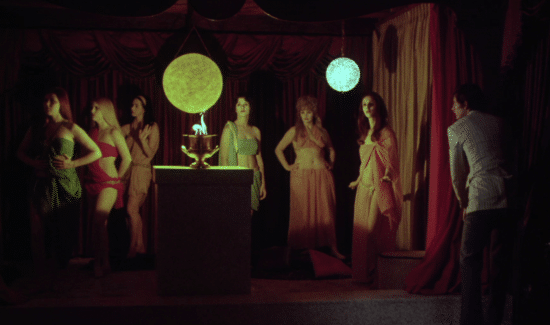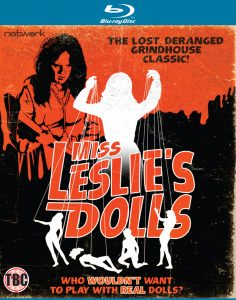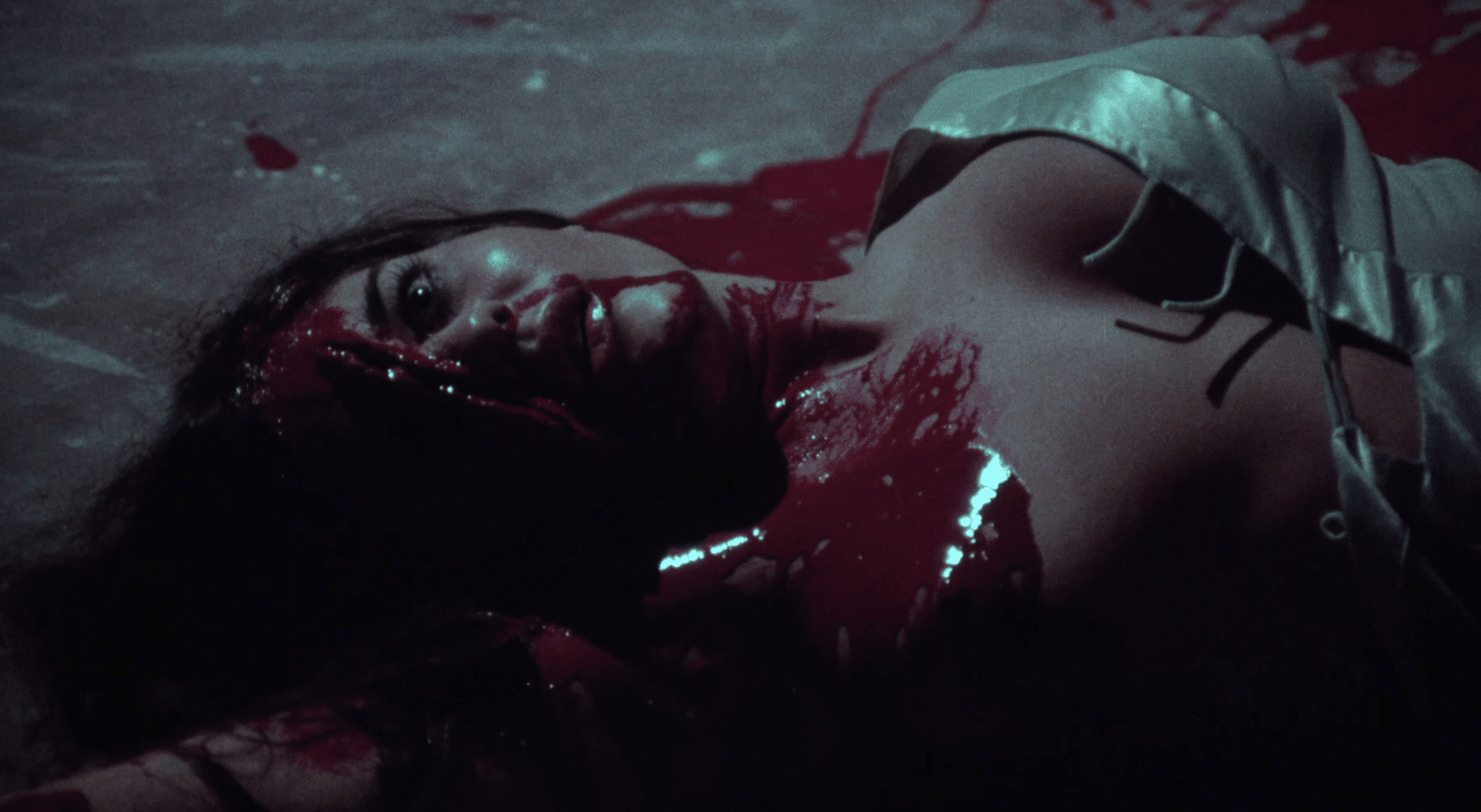 Talk about a movie in which a car breaks down during a storm forcing its passengers to seek refuge in a spooky old house nearby, only to find themselves the guests of a deranged transvestite who intends to use them for nefarious means, and odds are most people will think you’re referring to The Rocky Horror Picture Show. However, two years before that particular midnight movie first hit screens, that same basic premise was used, albeit with a comparatively straight face and bugger all singing and dancing, in largely forgotten grindhouse schlockfest Miss Leslie’s Dolls. I’ll confess it’s a film with which I had been totally unfamiliar before getting word of UK distributor Network bringing it to home entertainment, but I will concur with their press release that it is indeed a ‘memorably demented’ piece of work that’s likely to go down a storm with discerning connoisseurs of total trash.
Talk about a movie in which a car breaks down during a storm forcing its passengers to seek refuge in a spooky old house nearby, only to find themselves the guests of a deranged transvestite who intends to use them for nefarious means, and odds are most people will think you’re referring to The Rocky Horror Picture Show. However, two years before that particular midnight movie first hit screens, that same basic premise was used, albeit with a comparatively straight face and bugger all singing and dancing, in largely forgotten grindhouse schlockfest Miss Leslie’s Dolls. I’ll confess it’s a film with which I had been totally unfamiliar before getting word of UK distributor Network bringing it to home entertainment, but I will concur with their press release that it is indeed a ‘memorably demented’ piece of work that’s likely to go down a storm with discerning connoisseurs of total trash.
The stage is set nicely with a blood-curdling scream echoing across a graveyard on a dark and stormy night, and the fact that the gravestones appear to have been handcrafted out of cardboard makes it all the more pleasing. We then meet Miss Leslie (Salvador Ugarte, whose dialogue has clearly been overdubbed by someone a smidgen more feminine), as she reflects poetically on the nature of the storm, and expresses hopes to undergo something as dramatic and transformative herself, seemingly by means of the young and fresh-looking female corpse she’s just dug up. Next up we meet uptight college professor Alma Frost (Terri Juston) and her groovy young students Lily (Marcelle Bichette), Martha (Kitty Lewis) and Ray (Charles Pitts, the nearest thing we have to a famous face here as he went on to play the male lead in Russ Meyer’s Supervixens). The four of them are driving back to campus late at night, but what with the rain and the muddy road, it looks like they’re good and stuck, with no option but to seek shelter in the spooky old house overlooking the cemetery. Miss Leslie is as surprised to meet them as they are to meet her, but for all her eccentricity (including but not limited to professed occult beliefs, and some sort of shrine in the basement filled with what appear to be wax figures of Greek goddess-type figures), she proves an accommodating host, and soon enough offers them beds for the night. Not that any of them are poised to get much sleep…
 Arguably the key quality of true grindhouse is how it takes on taboo, often sensitive subject matter, and proceeds to handle it as insensitively as possible. Miss Leslie’s Dolls is absolutely no exception to that rule, given that its antagonist is a pathologically insane transgender woman. As we all know, the wider audience wasn’t all that ‘woke’ back in the early 70s, so from the get-go Miss Leslie is presented as a total whack job, mixing elements of Norman Bates (notably the gender dysphoria and mommy issues) and an old-school mad scientist, fixated on transferring her consciousness into a beautiful young woman’s body. Naturally she’s pleased to have no less than three to take her pick from, so the question becomes, which one will make the cut, as it were? And, credit where it’s due, things don’t necessarily go the way you initially expect. Even though the slasher format wasn’t quite out of the larval stage yet, we can see a lot of those same archetypes at work, with clear contenders for the final girl and the sinners bound for quick death, yet our expectations are played with in a fun and surprising manner.
Arguably the key quality of true grindhouse is how it takes on taboo, often sensitive subject matter, and proceeds to handle it as insensitively as possible. Miss Leslie’s Dolls is absolutely no exception to that rule, given that its antagonist is a pathologically insane transgender woman. As we all know, the wider audience wasn’t all that ‘woke’ back in the early 70s, so from the get-go Miss Leslie is presented as a total whack job, mixing elements of Norman Bates (notably the gender dysphoria and mommy issues) and an old-school mad scientist, fixated on transferring her consciousness into a beautiful young woman’s body. Naturally she’s pleased to have no less than three to take her pick from, so the question becomes, which one will make the cut, as it were? And, credit where it’s due, things don’t necessarily go the way you initially expect. Even though the slasher format wasn’t quite out of the larval stage yet, we can see a lot of those same archetypes at work, with clear contenders for the final girl and the sinners bound for quick death, yet our expectations are played with in a fun and surprising manner.
Miss Leslie’s Dolls also pushes the boundaries of the day, and comes off perhaps a little more progressive, with its portrayal of lesbianism. Given the one male, three female split of the college group, there’s initially a sense of the women competing for the man’s affections – yet this slowly but surely gives way to the suggestion that they might be more interested in one another, or indeed all of then at once. Still, while this might have been the era when hardcore broached the mainstream, this is not such a film, and beyond a fair number of topless shots, more is implied than shown. Nor, despite the gruesome shot at the top of the page, is there all that much gore on display. The real joy comes from the provocative subject matter, and the flagrantly amateurish way it’s all brought to life, with low production values, patchy performances and dialogue, and long stretches of tedium punctuated by glorious “what the fuck?” moments. The film may drag (no pun intended) in the opening act, but once things hit full tempo in the last half hour, the wait is well worth it.
As should hope I’ve made clear, Miss Leslie’s Dolls is not by any standard definition a good film. However, it’s pretty damn good as bad movies go, and anyone who loves a good bad movie should most definitely give it a look. It’s a pretty bare bones release, no extras on the Blu-ray beyond a small stills gallery, but I should think the film itself packs in lurid pleasures enough to warrant the price tag.
Network presents the worldwide Blu-ray & DVD debut of Miss Leslie’s Dolls on 3rd September, and Digital on 1st October.
